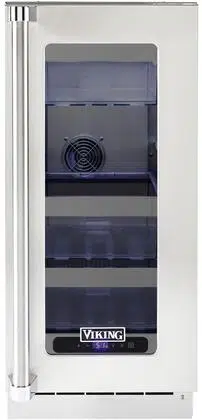Loading ...
Loading ...
Loading ...

18
Maintenance
Listed below are common refrigeration components with a
brief description of the normal operating sounds they
make. NOTE: Your product may not contain all the
components listed.
• Compressor: The compressor makes a hum or pulsing
sound that may be heard when it operates.
• Evaporator: Refrigerant owing through an evaporator
may sound like boiling liquid.
• Condenser Fan: Air moving through a condenser may be
heard.
• Automatic Defrost Drain Pan: Water may be heard
dripping or running into the drain pan when the unit is
in the defrost cycle.
TROUBLESHOOTING GUIDE
ELECTROCUTION HAZARD. Never attempt to repair or
perform maintenance on the unit before disconnecting the
main electrical power.
Troubleshooting - What to check when problems occur:
DANGER
!
Problem Possible Cause and Remedy
Interior Light
Does Not
Illuminate
If the unit is cooling, it may be in Sabbath
mode.
Light Remains
on When Door Is
Closed.
Turn o light switch if equipped.
Adjust light actuator bracket on bottom of
door.
Unit Develops
Frost on Internal
Surfaces.
Ensure the door is closing and sealing
properly.
Unit Develops
Condensation on
External Surfaces.
The unit is exposed to excessive humidity.
Moisture will dissipate as humidity levels
decrease.
Product is Not
Cold Enough
Air temperature does not indicate product
temperature. See CHECKING PRODUCT
TEMPERATURE below.
Adjust the temperature to a cooler set
point.
Ensure unit is not located in excessive
ambient temperatures or in direct sunlight.
Ensure the door is closing and sealing
properly.
Ensure the interior light has not remained
on too long.
Ensure nothing is blocking the front grille,
found at the bottom of the unit.
Ensure the condenser coil is clean and free
of any dirt or lint build-up.
CHECKING PRODUCT TEMPERATURE
To check the actual product temperature in the unit:
1. Partially ll a plastic (nonbreakable) bottle with water.
2. Insert an accurate thermometer.
3. Tighten the bottle cap securely.
4. Place the bottle in the desired area for 24 hours.
5. Avoid opening the unit during the testing period.
6. After 24 hours, check the temperature of the water.
If required, adjust the temperature control in a small
increment (see CONTROL OPERATION).
Causes which a ect the internal temperatures of the
cabinet include:
• Temperature setting.
• Ambient temperature where installed.
• Installation in direct sunlight or near a heat source.
• The number of door openings and the time the door is
open.
• The time the internal light is illuminated. (This mainly
a ects product on the top rack or shelf.)
• Obstruction of front grille or condenser.
Loading ...
Loading ...
Loading ...
